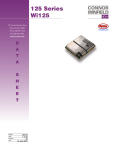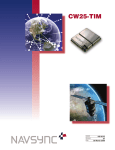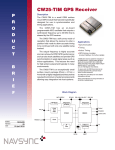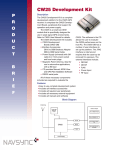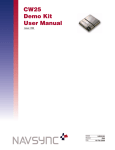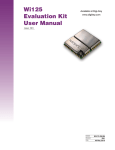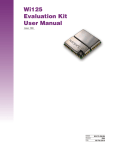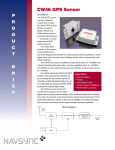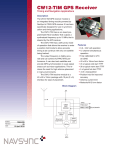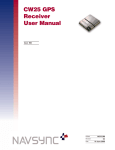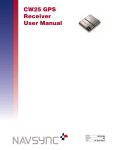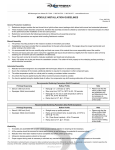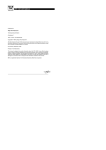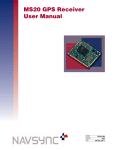Download CW-25 - NavSync
Transcript
CW25-TIM CW-25-TIM Data Sheet 2 Copyright ©2007 Navsync Ltd. All Rights Reserved Ver 3.0 Date: 08/20/07 Specifications subject to change without notice. Contents 1 INTRODUCTION ---------------------------------------------------------------------- 4 2 SPECIFICATION ---------------------------------------------------------------------- 6 2.1 2.2 2.3 2.4 3 PHYSICAL CHARACTERISTICS ---------------------------------------------------- 8 3.1 3.2 3.3 4 11 12 12 13 13 Power on Reset -----------------------------------------------------------------------Time Transfer -------------------------------------------------------------------------CW25-TIM Embedded Identification ------------------------------------------------CW25 Build Options ------------------------------------------------------------------User Commands ----------------------------------------------------------------------- 15 16 16 16 16 APPLICATION HINTS --------------------------------------------------------------- 17 6.1 6.2 6.3 7 Power Signals -------------------------------------------------------------------------RF Signals -----------------------------------------------------------------------------Emulation/Test Signals ---------------------------------------------------------------Control Signals ------------------------------------------------------------------------I/O Signals ----------------------------------------------------------------------------- SPECIAL FEATURES ---------------------------------------------------------------- 15 5.1 5.2 5.3 5.4 5.5 6 Physical Interface Details --------------------------------------------------------------- 8 CW25-TIM Dimensions ----------------------------------------------------------------- 9 Solder Pad Size and Placement -------------------------------------------------------- 9 SIGNAL DESCRIPTION ------------------------------------------------------------- 11 4.1 4.2 4.3 4.4 4.5 5 Performance ----------------------------------------------------------------------------- 6 Recommended Ratings ----------------------------------------------------------------- 7 Absolute Maximum Ratings ------------------------------------------------------------ 7 Block Diagram --------------------------------------------------------------------------- 7 Power Supply -------------------------------------------------------------------------- 17 RF Connection ------------------------------------------------------------------------- 17 Grounding ------------------------------------------------------------------------------ 18 BATTERY BACKUP ----------------------------------------------------------------- 19 7.1 7.2 7.3 7.4 Over Voltage & Reverse Polarity Protection ----------------------------------------LEDs -----------------------------------------------------------------------------------Reset Generation ---------------------------------------------------------------------Boot Options --------------------------------------------------------------------------- CW-25-TIM Data Sheet Ver 3.0 Copyright ©2007 Navsync Ltd. All Rights Reserved 19 19 19 19 Date: 08/20/07 Specifications subject to change without notice. 3 Figure and Table Contents List of Figures Figure 1 Figure 2 Figure 3 Figure 4 Figure 5 Figure 6 Figure 7 CW25-TIM Block Diagram ------------------------------------------------------------------- 7 CW25-TIM Form and Size -------------------------------------------------------------------- 8 CW25-TIM Dimensions ----------------------------------------------------------------------- 9 Solder Pad Size and Placement ----------------------------------------------------------- 10 RF Tracking Example ----------------------------------------------------------------------- 17 Grounding the CW25-TIM with a ground plane ------------------------------------------ 18 Typical VBATT Supplies -------------------------------------------------------------------- 19 List of Tables Table 1 Revision History -------------------------------------------------------------------------------- 2 Table 2 Additional Documentation List ---------------------------------------------------------------- 3 Table 3 CW25-TIM Specification ----------------------------------------------------------------------- 6 Table 4 Absolute Maximum Ratings ------------------------------------------------------------------- 7 Table 5 Absolute Maximum Ratings ------------------------------------------------------------------- 7 Table 6 CW25-TIM Signal List ------------------------------------------------------------------------- 8 Table 7 RF Track & Gap Widths ---------------------------------------------------------------------- 17 Revision History of Version 1.0 Revision 1 Date 08/08/05 Released By Rob Rae 2 07/03/07 Katie Foote 3 8/20/07 Katie Foote Note New version reflecting interfaces performance Testing & Evaluating update Table 1 Revision History Other Documentation The following additional documentation may be of use in understanding this document. Document CW25 User Manual By Navsync CW25 Dev Kit User Manual Navsync Note Table 2 Additional Documentation List CW-25-TIM Data Sheet 4 Copyright ©2007 Navsync Ltd. All Rights Reserved Ver 3.0 Date: 08/20/07 Specifications subject to change without notice. 1 INTRODUCTION The CW25-TIM is a small size GPS OEM module that has been optimized for accurate timing applications. Leveraging Navsync’s core CW25 platform that utilizes 12288 correlators in the BB25IC baseband processor to search for low-signal strength GPS signals, the CW25-TIM assumes a positional lock after initially acquiring satellites to optimize GPS timing accuracy. Aside from low signal tracking, which is more applicable for GPS location rather than timing applications, the BB25’s algorithms also support quick Time To First Fix (TTFF), when ephemeris and almanac data is available and also in cold start environments. The low signal tracking capabilities have benefits within fixed timing applications by reducing the cost of installations by lessening the burden of high antenna mounts. GPS timing certain will degrade if the GPS antenna is entirely obscured or put indoors, but tracking will continue. Equipment using a CW25-TIM can operate in installations without open-sky access and even some indoor environments. With a size of just over an inch square (25 x 27 mm) and provided as a tape and reel component, the CW25-TIM is specifically designed to be integrated with Communications devices such as GSM, CDMA, UMTS modems or any other communications medium. The CW25-TIM is optimised for the output of time/ frequency information. Another aid to integration is the ability to store users’ software code in the CW25-TIM, reducing the need for external memory and processors. Key Features of the CW25-TIM include: • 25 nsec accuracy to UTC • Enables indoor use -185 dBW acquisition with network assist -186 dBW tracking -173 dBW acquisition stand alone • Rapid Time To Fix <2 second outdoors <5 second indoor (-178dBW) • Standalone CW25-TIM module No GPS knowledge required for hardware integration • 25 mm x 27 mm x 4.2 mm This document, the CW25-TIM Data Sheet, provides information on the Hardware Elements of the CW25-TIM. CW-25-TIM Data Sheet Ver 3.0 Copyright ©2007 Navsync Ltd. All Rights Reserved Date: 08/20/07 Specifications subject to change without notice. 5 Key information includes: • System Block Diagram • Maximum Ratings • Physical Characteristics CW25-TIM Dimensions, castellation information Solder Pad and placement information • Signal Descriptions • Special Features • Application Information Power supply modes RF connections Grounding Battery Back-up Over Voltage and Reverse Polarity LED’s The specifications in the following sections refer to the standard software builds of the CW25-TIM. The performance and specification of the CW-25TIM can be modified with the use of customized software builds. CW-25-TIM Data Sheet 6 Copyright ©2007 Navsync Ltd. All Rights Reserved Ver 3.0 Date: 08/20/07 Specifications subject to change without notice. 2 SPECIFICATION 1 2.1 Performance Physical Module dimensions Supply voltages Operating / Storage Temp Humidity Max Velocity / Altitude Max Acceleration / Jerk 25mm (D) x 27mm (W) x 4.2mm (H) 3V3 (Digital I/O), 3V3 (RF), 1V8 (Core option), 3V (Standby Battery) -30°C to +75°C / -30°C to +80°C 2 5% to 95% non-condensing 515ms-1 / 18,000m 4g / 1gs-1 (sustained for less than 5 seconds) Sensitivity Acquisition w/network assist Tracking Aquisition Stand Alone -185dBW -186dBW -173dBW Acquisition Time Hot Start with network assist Outdoor: <2s Indoor (-178dBW): <5s Cold: <45s Warm: <38s Hot: <5s Re-acquisition: <0.5s (90% confidence) Stand Alone (Outdoor) Accuracy Position: Outdoor / Indoor Velocity Latency Raw Measurement Accuracy Tracking <5m rms / <50m rms <0.05ms-1 <200ms Pseudorange <0.3m rms, Carrier phase <5mm rms Code and carrier coherent Power 1 fix per second Coma Mode Current (RF3V3+DIG 3V3) Standby Current (VBATT) 0.6W typically 10mA Interfaces Serial Multi-function I/O 1.5µA Protocols 1pps Timing Output Event Input Frequency Output (GPIO [0]) Receiver Type General Processor 3 UART ports, CMOS levels 1PPS Frequency Output available on GPIO [0] Event Counter/Timer Input Up to 4 x GPIO (multi-function) 2 x LED Status Drive I2C, External Clock (on special build) Network Assist, NMEA 0183, Proprietary ASCII and binary message formats 30ns rms accuracy, <5ns resolution User selectable pulse width 30ns rms accuracy, <10ns resolution 10 Hz to 30 MHz (CW25-TIM) 12 parallel channel x 32 taps up to 32 point FFT. Channels, taps and FFT can be switched off to minimize power or simulate simpler designs. ARM 966E-S on a 0.18µ process at up to 120 MHz. Note: 1. The features listed above may require specific software builds and may not all be available in the initial release. 2. Please contact factory for other temperature options. Table 3 CW25-TIM Specification CW-25-TIM Data Sheet Ver 3.0 Copyright ©2007 Navsync Ltd. All Rights Reserved Date: 08/20/07 Specifications subject to change without notice. 7 2.2 Recommended Ratings Symbol Parameter Min Max Units RF_3V3 RF Supply Voltage +3.0 +3.6 Volts DIG_3V3 Digital Supply Voltage +3.0 +3.6 Volts DIG_1V8 Digital Supply Voltage +1.65 +1.95 Volts VBATT Battery Backup Voltage +2.7 +3.5 Volts ANT_SUPPLY Antenna Supply Voltage +3.0 +12 Volts Table 4 Recommended Maximum Ratings 2.3 Absolute Maximum Ratings Symbol Parameter Min Max Units RF_3V3 RF Supply Voltage -0.3 +6.5 Volts DIG_1V8 Digital Supply Voltage -0.3 +2.0 Volts DIG_3V3 Digital Supply Voltage -0.3 +3.7 Volts VBATT Battery Backup Voltage -0.5 +7.0 Volts ANT_SUPPLY Antenna Supply Voltage -15 +15 Volts DIG_SIG_IN Any Digital Input Signal -0.3 +5.5 Volts RF_IN RF Input -15 +15 Volts TSTORE Storage temperature -30 +80 °C IOUT Digital Signal Output Current -6 +6 mA Table 5 Absolute Maximum Ratings 2.4 Block Diagram ANT_SUPPLY RF Block RF_IN RF_3V3 DIG_1V8/+1V8_OUT Regulator & Reset Regulator Control Front End Filter Emulation RF25IC TRIM/EXT_CLK DIG_3V3 BB25IC Comms & I/O Clock IF Filter 2 IC RTC & EEPROM NPOR VBATT Figure 1 CW25-TIM Block Diagram CW-25-TIM Data Sheet 8 Copyright ©2007 Navsync Ltd. All Rights Reserved Ver 3.0 Date: 08/20/07 Specifications subject to change without notice. 3 PHYSICAL CHARACTERISTICS The CW25-TIM is a multi-chip module (MCM) built on an FR4 fibreglass PCB. All digital and power connections to the CW25-TIM are via castellations on the 25 x 27 mm PCB. The RF connection is via castellations or an RF connector. The general arrangement of the CW25-TIM is shown in the diagram below. Dimensions in mm (inches/1000). HIROSE COAX CONNECTOR . TYPE SMT H.FL O: . - PART NO: H.FL-4-SMT (C) (10) Actual Size Figure 2 CW25-TIM Form and Size 3.1 Physical Interface Details The interface to the CW25-TIM is via 1mm castellations on a 2mm pitch. There are 42 connections in all. There is also an RF connector for connecting to the GPS antenna. The details of the interface connections are given below. Pin Function Pin Function Pin Function 1 TX[0] 15 NTRST 29 N2WDA 2 RX[0] 16 NPOR 30 USBP 3 TX[2] 17 RFV_OUT 31 USBN 4 RX[2]/EV2_IN 18 RF_GND 32 FREQ_OUT 5 TX[1] 19 RF_3V3 33 +1V8_OUT 6 RX[1] 20 TCK 34 DIG_1V8 7 EXT_CLK 21 JTAGSEL/RTCK 35 DIG_GND 8 LED_RED 22 TMS 36 DIG_3V3 9 LED_GRN 23 RF_GND 37 EVENT_IN 10 NRESET 24 RF_IN 38 1PPS 11 BOOTSEL 25 RF_GND 39 GPIO[0]/PWM_OUT 3 12 TRIM 26 ANT_SUPPLY 40 GPIO[1]/TIME_SYNC 13 TDO 27 VBATT 41 GPIO[2]/NEXT_INT 14 TDI 28 N2WCK 42 GPIO[3]/FREQ_IN Note: 3. The 10 Hz to 30 MHz frequency output is available on pin 39 (GPIO[0] / PWM_OUT) and not on FREQ_OUT. Table 6 CW25-TIM Signal List CW-25-TIM Data Sheet Ver 3.0 Copyright ©2007 Navsync Ltd. All Rights Reserved Date: 08/20/07 Specifications subject to change without notice. 9 3.2 CW25-TIM Dimensions The figure below provides the dimensions of the positioning of the CW25-TIM castellations. Dimensions in mm (inches/1000). Figure 3 CW25-TIM Dimensions 3.3 Solder Pad Size and Placement It is recommended that the footprint of the solder pad under each castellation be 2mm x 1mm, centred on the nominal centre point of the radius of the castellation. The castellations are gold plated and so are lead free. Note that if the RF_IN connector is being used, there should not be a pad or solder resist under the RF_IN castellation. If the RF_IN castellation is to be used, the pad should be shortened by 0.5mm underneath the CW25-TIM and standard RF design practices must be observed. The diagram below shows the placement of the pads under the castellations. PIN 22 RF_IN Figure 4 Solder Pad Size and Placement CW-25-TIM Data Sheet 10 Copyright ©2007 Navsync Ltd. All Rights Reserved Ver 3.0 Date: 08/20/07 Specifications subject to change without notice. 4 SIGNAL DESCRIPTION The signals on the CW25-TIM are described in the table below. 4.1 Power Signals RF_3V3 Type: Power Direction: Input Pin: 19 The RF supply input. This 3.3V ± 10% input supplies the 2.9V LDO regulator in the RF section of the CW25-TIM. It is important that this supply is well filtered with no more that 50mV peak to peak noise with respect to RF_GND. RF_GND Type: Power Direction: Input/Output Pins: 18, 23, 25 The RF input ground. This is the return path for the RF_3V3 supply and the ground for the antenna feed. The RF_GND must be tied to the DIG_GND externally to the CW25-TIM. RFV_OUT Type: Power Direction: Output Pin: 17 The output from the LDO regulator that is powered by the RF_3V3 signal. This supplies the power to the RF subsystem of the CW25-TIM. This may also be used to power external RF components but care must be taken not to inject noise onto this signal. No more than an additional 30mA may be taken from this signal by external circuitry. ANT_SUPPLY Type: Power Direction: Input Pin: 26 The antenna supply voltage. This may be used to supply power to the RF_IN signal, for use by an active antenna. The maximum voltage should not exceed ±15V and the current should be limited to 50mA. DIG_3V3 Type: Power Direction: Input Pin: 36 The digital supply input. This 3.3V ± 10% input supplies the I/O ring of the BB25IC chip and the LDO regulator in the digital section of the CW25-TIM. It is important that this supply is well filtered with no more that 50mV peak to peak noise with respect to DIG_GND. DIG_1V8 Type: Power Direction: Input Pin: 34 The 1.8V ± 5% digital core supply for the BB25IC. This is normally connected directly to the +1V8_OUT signal. However, if an external 1.8V ± 5% is available, a lower overall system power consumption may be achieved by using an external supply. +1V8_OUT Type: Power Direction: Output Pin: 33 The 1.8V output from the LDO regulator that is powered by the DIG_3V3 signal. Normally, this is connected to the DIG_1V8 signal. This may also be used to power external logic but care must be taken not to inject noise onto this signal. No more than an additional 50mA may be taken from this signal by external logic. DIG_GND Type: Power Direction: Input/Output Pin: 35 The digital ground. This is the return path for the DIG_3V3 supply and the ground reference for all the digital I/O. The DIG_GND must be tied to the RF_GND externally to the CW25-TIM. CW-25-TIM Data Sheet Ver 3.0 Copyright ©2007 Navsync Ltd. All Rights Reserved Date: 08/20/07 Specifications subject to change without notice. 11 4 SIGNAL DESCRIPTION continued 4.1 Power Signals cont’d VBATT Type: Power Direction: Input/Output Pin: 27 The battery backup supply. The CW25-TIM has an on board Real Time Clock (RTC). This is powered from the VBATT signal. A supply of typically 3v (greater than 2.5V and less than DIG_3V3) should be applied to this signal. This signal can be left floating if not required. The input has a blocking diode and so rechargeable batteries will need an external charging circuit. Typically, a 1K resister in series with this signal and the external battery will provide an easy method of measuring the current consumption from VBATT during test. 4.2 RF Signals RF_IN Type: RF Direction: Input Pin: 24 The RF input signal. This attaches to the GPS antenna. Standard RF design rules must be used when tracking to this signal. This signal has an RF blocked connection to the ANT_SUPPLY signal. This is the same signal presented on the RF connector on the CW25-TIM. Only one antenna connection should be made. If the RF connector is to be used, then there should be no connection, even an unconnected pad, to this castellation. TRIM Type: RF Direction: Input Pin: 12 This signal trims the output frequency of the VCTCXO. This signal is normally left open. When floating, this signal is biased to the control voltage of the VCTCXO. Any noise injected into this signal will severely compromise the performance of the CW25-TIM. This signal should only be used in conjunction with specific application notes. EXT_CLK Type: RF Direction: Input Pin: 7 This signal normally has no internal connection in the CW25-TIM. In special builds of the CW25-TIM that are not fitted with an internal VCTCXO, this input is the external clock input. The external clock is a 9MHz to 26MHz clipped sign wave input with an amplitude between 1V and 3V peak to peak. The return path for this signal is RF_GND. 4.3 Emulation/Test Signals TDI Type: Test Direction: Input Pin: 14 The Test Data In signal. This is the standard JTAG test data input. The signal return path is DIG_GND. TDO Type: Test Direction: Output Pin: 13 The Test Data Out signal. This is the standard JTAG test data output. The signal return path is DIG_GND. CW-25-TIM Data Sheet 12 Copyright ©2007 Navsync Ltd. All Rights Reserved Ver 3.0 Date: 08/20/07 Specifications subject to change without notice. 4 SIGNAL DESCRIPTION continued 4.3 Power Signals cont’d TCK Type: Test Direction: Input Pin: 20 The Test Clock signal. This is the standard JTAG test clock input. The signal return path is DIG_GND. TMS Type: Test Direction: Input Pin: 22 The Test Mode Select signal. This is the standard JTAG test mode input. The signal return path is DIG_GND. JTAGSEL/RTCK Type: Test Direction: Input/Output Pin: 21 This is a dual function signal. When the NPOR signal is asserted (low), this signal is an input and selects the function of the JTAG interface. When high, JTAG emulation into the embedded ARM9 processor is selected. When low, the BB25IC chip boundary scan mode is selected. The value on this signal is latched when NPOR de-asserts (goes high). When NPOR is de-asserted (high) and the JTAG emulation mode has been latched, this signal provides the return clock to the ARM Multi-ICE. Because the ARM9 functions off a single clock domain, the TCK has to be internally synchronised in the ARM9. This can cause a variable length delay in the validity of the TDO signal. The RTCK is a synchronised version of the TCK signal. The Multi-ICE uses the RTCK output signal to indicate when the TDO signal is valid. The signal return path is DIG_GND. NTRST Type: Test Direction: Input Pin: 15 The Test Reset signal. This is the active low JTAG test reset signal. The signal return path is DIG_GND. 4.4 Control Signals NPOR Type: Control Direction: Input/Output Pin: 16 The Power On Reset signal. This active low, open collector signal is the master reset for the CW25-TIM. The CW25-TIM can be held in reset by asserting this signal. The signal can be used to reset external circuitry, but care must be taken to ensure no DC current is drawn from this signal as the internal pull-up resistor value is 100K. NRESET Type: Control Direction: Input/Output Pin: 10 The system reset signal. This active low, open collector signal is generated by the BB25IC chip in response to the assertion of the NPOR. It may also be driven to reset the ARM9 processor in the BB25IC without completely reinitialising the chip. BOOTSEL Type: Control Direction: Input Pin: 11 The boot select signal. The BB25IC has four boot up modes, but only two are supported by the CW25-TIM. This signal is sampled when the NPOR is deasserted. If the BOOTSEL signal is high or left floating, then the CW25-TIM boots from its on-chip FLASH memory. If the BOOTSEL signal is pulled low, the CW25-TIM boots from its on-chip ROM. CW-25-TIM Data Sheet Ver 3.0 Copyright ©2007 Navsync Ltd. All Rights Reserved Date: 08/20/07 Specifications subject to change without notice. 13 4 SIGNAL DESCRIPTION continued 4.5 I/O Signals TX[0] Type: I/O Direction: Output Pin: 1 The transmit signal for UART 0. This is a standard UART output signal. The signal return path is DIG_GND. TX[1] Type: I/O Direction: Output Pin: 5 The transmit signal for UART 1. This is a standard UART output signal. The signal return path is DIG_GND. TX[2] Type: I/O Direction: Output Pin: 3 The transmit signal for UART 2. This is a standard UART output signal. The signal return path is DIG_GND. RX[0] Type: I/O Direction: Input Pin: 2 The receive signal for UART 0. This is a standard UART input signal. The signal return path is DIG_GND. RX[1] Type: I/O Direction: Input Pin: 6 The receive signal for UART 1. This is a standard UART input signal. The signal return path is DIG_GND. RX[2]/EV2_IN Type: I/O Direction: Input Pin: 4 This is a dual mode signal. Normally, this is the receive signal for UART 2, a standard UART receive signal. Under software control, it can also be used as general purpose I/O or to detect events. It can be used to detect the timing of the leading edge of the start bit of the incoming data stream. The signal return path is DIG_GND. FREQ_OUT Type: I/O Direction: Input/Output Pin: 32 Optional frequency output signal. This is NOT the same signal as pin 30. This signal is turned off by default. This is a complex signal which under software can provide any of either an NCO generated output frequency, a PWM signal, a GPS aligned EPOCH pulse or general purpose I/O signal. The signal return path is DIG_GND. 1PPS Type: I/O Direction: Input/Output Pin: 38 The 1 pulse per second signal. This is normally a 1 pulse aligned with GPS time, but can under software control also provide general purpose I/O or an additional even input. The pulse width of the 1PPS is software selectable with a default of 100µs. The signal return path is DIG_GND. EVENT_IN Type: I/O Direction: Input/Output Pin: 37 The event input signal. This is normally an event timer or counter. Events are timed against GPS time. Under software control, this input can be used as an external 48MHz input for the USB interface or this input can also be used for general purpose I/O. The signal return path is DIG_GND. CW-25-TIM Data Sheet 14 Copyright ©2007 Navsync Ltd. All Rights Reserved Ver 3.0 Date: 08/20/07 Specifications subject to change without notice. 4 SIGNAL DESCRIPTION continued 4.5 I/O Signals cont’d N2WCK Type: I/O Direction: Input/Output Pin: 28 The Navsync 2 Wire Clock signal. This is the open collector I2C compatible clock signal for the 2 wire serial interface. The signal return path is DIG_GND. N2WDA Type: I/O Direction: Input/Output Pin: 29 The Navsync 2 Wire Data signal. This is the open collector I2C compatible data signal for the 2 wire serial interface. The signal return path is DIG_GND. USBP 4 Type: I/O Direction: Input/Output Pin: 30 The positive USB signal. The signal return path is DIG_GND. USBN 4 Type: I/O Direction: Input/Output Pin: 31 The negative USB signal. The signal return path is DIG_GND. LED_RED Type: I/O Direction: Output Pin: 8 This is a dual function signal. Normally this signal is used to drive a red LED. Standard software builds use this signal to indicate GPS status. In special software builds, this signal can be used as GPIO. This signal has a 3.3V CMOS drive. A series limiting resistor is required to limit output current to ±5mA. The signal return path is DIG_GND. LED_GRN Type: I/O Direction: Output Pin: 9 This is a dual function signal. Normally this signal is used to drive a green LED. Standard software builds use this signal to indicate GPS status. In special software builds, this signal can be used as GPIO. This signal has a 3.3V CMOS drive. A series limiting resistor is required to limit output current to ±5mA. The signal return path is DIG_GND. GPIO[0]/PWM Type: I/O Direction: Input/Output Pin: 39 The GPIO[0] signal. This is the default Frequency Output pin. Primarily for general purpose I/O, this signal can also be programmed to provide either a frequency, PWM or EPOCH output. Defaults to 10 MHz, Maximum is 30 MHz. The output is always enabled. It can also be configured to form and external RC oscillator in combination with GPIO[3]. The signal return path is DIG_GND. GPIO[1]/TIME_SYNC Type: I/ODirection: Input/Output Pin: 40 The GPIO[1] signal. Primarily for general purpose I/O, this signal can also be programmed to provide either an additional PPS output or a time synchronisation input to the GPS engine in the BB25IC chip. The synchronisation pulse can be provided from an external source or can be generated by the on-board RTC. When generated by the onboard RTC, the synchronisation signal can be observed on this pin signal. The signal return path is DIG_GND. Note: 4. USB is not supported in the current software build. CW-25-TIM Data Sheet Ver 3.0 Copyright ©2007 Navsync Ltd. All Rights Reserved Date: 08/20/07 Specifications subject to change without notice. 15 4 SIGNAL DESCRIPTION continued 4.5 I/O Signals cont’d GPIO[2]/NEXT_INT Type: I/O Direction: Input/Output Pin: 41 The GPIO[2] signal. Primarily for general purpose I/O, this signal can also be programmed to provide an interrupt event from an active low external input. The signal return path is DIG_GND. GPIO[3]/FREQ_IN Type: I/O Direction: Input/Output Pin: 42 The GPIO[3] signal. Primarily for general purpose I/O, this signal can also be programmed to provide a frequency counter input. The frequency counter input has a Schmitt trigger and if used with GPIO[0] can be configured to form a temperature controlled oscillator. The signal return path is DIG_GND. 5 SPECIAL FEATURES While most of the features on the CW25-TIM are just a subset of the capabilities of the CW25 and so are described in the CW25 Data Sheet and the CW25 User Manual, there are some additional features buried in the CW25-TIM that need specific explanation, especially if use is to be made of them by user application code. 5.1 Power on Reset The power on reset for the CW25-TIM is generated on-board by the regulator in the RF section from the RF_3V3 signal. The RF_3V3 signal must be applied to the CW25-TIM at the same time as the DIG_3V3, if the on-board power on reset is to be used. If an external source of reset is to be applied to the NPOR signal after both the RF_3V3 and the DIG_3V3 signals are valid, this restriction does not apply. 5.2 Time Transfer In order to aid time transfer between fixes during which the CW25-TIM has been unable to maintain an accurate perception of time (eg. in deep sleep or powered down states), the on-board RTC can be set to provide a signal derived from the 32.768Hz crystal. 5.3 CW25-TIM Embedded Identification The hardware version number is hard coded onto the CW25-TIM; firmware also contains a version number allowing for easy identification of the hardware and software version in embedded applications. 5.4 User Commands The CW25-TIM can accept a number of specific user commands that can be used to set receiver parameters such as UART baud rate and message subset. NCO frequency, 1 pps initialization etc. These commands are defined in detail within the CW25 User Manual and the set values are stored in Non-Volatile Memory (NVM) within the CW25-TIM receiver. CW-25-TIM Data Sheet 16 Copyright ©2007 Navsync Ltd. All Rights Reserved Ver 3.0 Date: 08/20/07 Specifications subject to change without notice. 6 APPLICATION HINTS The following are a list of application hints that may help in implementing system based on the CW25-TIM. 6.1 Power Supply The power supply requirements of the CW25-TIM can all be provided from a single 3.3V supply. To simplify system integration on-board regulators provide the correct voltage levels for the RF and oscillator (2.9V or 3.0V) and low voltage digital core (1.8V). In power sensitive applications it is recommended that the DIG_1V8 supply is provided from a high efficiency external 1.8V source e.g. switch mode power supply, rather than the on-board linear regulator. If the source impedance of the power supply to the CW25-TIM is high due to long tracks, filtering or other causes, local decoupling of the supply signals may be necessary. Care should be taken to ensure that the maximum supply ripple at the pins of the CW25-TIM is 50mV peak to peak. 6.2 RF Connection The RF connection to the CW25-TIM can be done in two ways. The preferred method is to use standard microstrip design techniques to track from the antenna element to the RF_IN castellation,. This also allows the systems integrator the option of designing in external connectors suitable for the application. The user can easily fit an externally mounted MCX, SMA or similar connector, provided it is placed adjacent to the RF_IN castellation. If the tracking guidelines given below are followed, the impedance match will be acceptable. The diagram below shows how this could be achieved. In this diagram, the centre via of the RF connector is presumed to be plated through with a minimal pad top and bottom. The PCB material is assumed to be 1.6mm thick FR4 with a dielectric constant of 4.3. Two situations are considered; one with no ground plane and one with a ground plane on the bottom of the board, underneath the RF connector. In both cases there is no inner layer tracking under the RF connector. RF_IN PIN 22 Top Tracking Ground Plane (if used) SMA Connector Figure 5 RF Tracking Example CW-25-TIM Data Sheet Ver 3.0 Copyright ©2007 Navsync Ltd. All Rights Reserved Date: 08/20/07 Specifications subject to change without notice. 17 The widths of the RF_IN track and the associated gaps are given in the table below. Scenario Without ground plane With ground plane Track Width (1/1000 Inch) 37 56 Gap Width (1/1000 Inch) 6 8 32 43 6 8 Table 7 RF Track & Gap Widths Alternatively, the user can attach the antenna to the Hirose H.FL-R-SMT using a flying lead fitted with a suitable plug. 6.3 Grounding In connecting the CW25-TIM into a host system, good grounding practices should be observed. Specifically, ground currents from the rest of the system hosting the CW25-TIM should not pass through the ground connections to the CW25-TIM. This is most easily ensured by using a single point attachment for the ground. There must also be a good connection between the RF_GND and the DIG_GND signals. Whilst there is not a specific need to put a ground plane under the CW25-TIM, high energy signals should not be tracked under the CW25-TIM. It is however recommended that a ground plane be used under the CW25-TIM. In this case, the following would be an example of the pattern that may be used Double via to host system ground at this one point. Digital and RF grounds common at this point. Figure 6 Grounding the CW25-TIM with a Ground Plane CW-25-TIM Data Sheet 18 Copyright ©2007 Navsync Ltd. All Rights Reserved Ver 3.0 Date: 08/20/07 Specifications subject to change without notice. 7 Battery Backup The CW25-TIM has an on-board real time clock (RTC). This is used to store date and time information whilst the CW25-TIM is powered down. Having a valid date and time speeds the time to first fix (TTFF), allowing the CW25-TIM to meet its quoted TTFF specification. The CW25-TIM relies on an external power source to power the RTC (VBATT) when the DIG_3V3 is not present. If the user application does not require the warm or hot fix performance, or the required information is provided by network assistance, there is no need to provide the VBATT signal. The VBATT signal must be greater than 2.6V and less than DIG_3V3 + 0.6V. Typically, a 3V lithium primary cell or a high capacity “supercap” will be used. The CW25-TIM has an internal blocking diode, so if a “supercap” or rechargeable battery is used, an external charging circuit will be required. DIG_3V3 100R 1K VBATT CR2032 Cell 1K VBATT 0.47F Supercap DIG_GND DIG_GND Figure 7 Typical VBATT Supplies The 1K resistor is recommended at it limits current in the VBATT circuit and provides an easy way to measure the current in the VBATT signal. The 100R limits the inrush current into the “supercap”. 7.1 Over Voltage & Reverse Polarity Protection The CW25-TIM contains no over voltage or reverse polarity protection. The CW25-TIM should be handled as a CMOS component, with full antistatic handling precautions. Any fault condition that results in the maximum limits being exceeded may irreparably damage the CW25-TIM. 7.2 LEDs There are two connections on the CW25-TIM specifically intended to drive status LEDs. The LED_RED and LED_GRN signals should be connected, via suitable current limiting resistors, to the anodes of low current LEDs whose cathodes are connected to DIG_GND. The outputs are standard 3.3V CMOS and the current drawn should be limited to 5mA per output. Using a 270 ohm resistor provides a suitable current limit. If appropriately coloured LEDs are attached to these signals, other documentation (eg. CW25 user manuals) that refers to these status LEDs will be correct. If LEDs are not required, these signals can be left open. These signals may be connected to other logic if required. 7.3 Reset Generation The power on reset for the CW25-TIM is generated on-board. It is generated by the regulator for the RF section. This signal is an active low, open collector signal and is presented on the NPOR castellation. If it is desired to extend the power on reset signal or provide a manual reset for the CW25-TIM, this signal can be driven from an open collector source at any time. The nPOR signal of the BB25IC, to which the NPOR castellation is connected, has a Schmitt trigger input. This means that there are no constraints on the rise time of the NPOR signal. There is a second reset signal on the CW25-TIM, the NRESET signal. NRESET is also an active low open collector signal. This signal is generated by the BB25IC in response to the NPOR signal. It can also be generated under software control. Asserting the NRESET signal from an external open collector source will reset the ARM9 in the BB25IC without resetting the whole chip. Generally, this signal will be left open. 7.4 Boot Options The CW25-TIM has two boot modes. These are selected by the state of the BOOTSEL signal when the NPOR signal goes inactive (high). Normally, BOOTSEL is left open so that a pull-up bias in the BB25IC will keep that signal high. When BOOTSEL is high, the CW25-TIM boots from the FLASH that is internal to the BB25IC. If BOOTSEL is tied low, the CW25-TIM boots from the ROM internal to the BB25IC. This ROM has a boot loader that polls the serial ports and I2C bus for boot code. This mode of operation requires special user handling and should only be used in conjunction with specific application notes. CW-25-TIM Data Sheet Ver 3.0 Copyright ©2007 Navsync Ltd. All Rights Reserved Date: 08/20/07 Specifications subject to change without notice. 19 CW25-TIM NavSync Ltd. Headquarters Bay 143 Shannon Industrial Estate Shannon, Co. Clare, Ireland Phone: +353 61 475 666 E-mail: [email protected] In North America 2111 Comprehensive Drive Aurora, IL 60505, USA Phone: 630.236.3026 E-mail: [email protected] www.navsync.com




















